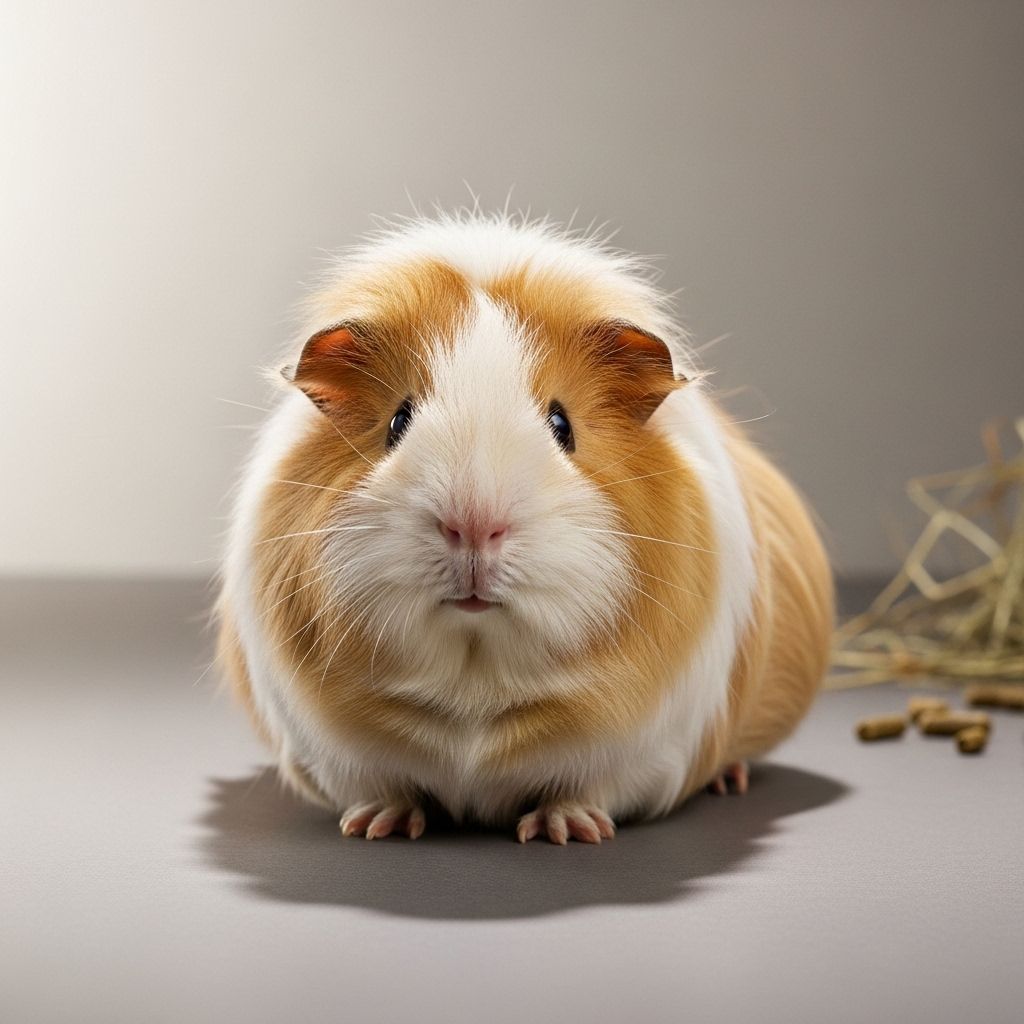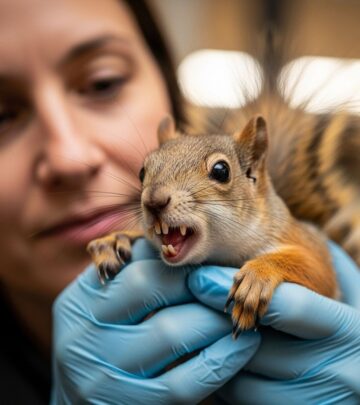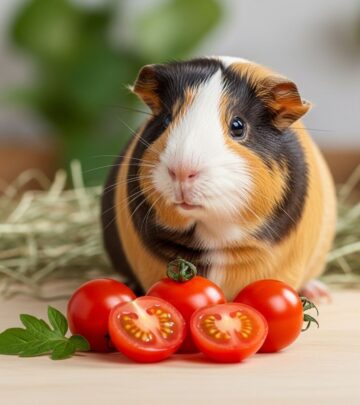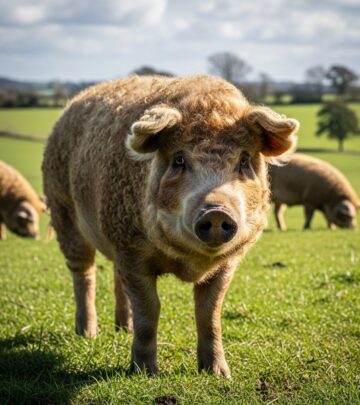Teddy Guinea Pig: Breed Profile, Care Guide, and Facts
A plush companion with easy grooming needs and a playful, social spirit.

Image: HearthJunction Design Team
The Teddy Guinea Pig stands out as one of the most endearing and unique guinea pig breeds. Renowned for its dense, wiry fur, friendly nature, and low-maintenance grooming needs, this breed is favored by both first-time and seasoned cavy owners. This comprehensive guide explores the Teddy Guinea Pig’s origin, appearance, temperament, essential care, and more, to help you better understand and care for these plush companions.
Breed Overview
| Common Name | Teddy Guinea Pig |
|---|---|
| Scientific Name | Cavia porcellus |
| Adult Size | 10–12 inches long, 1–3.5 pounds |
| Lifespan | 4–7 years |
| Coat Type | Short, dense, plush, upright hair |
| Color Variations | Gold, black, brown, chestnut, white, cream, lilac, brindle, multicolored |
| Temperament | Active, social, curious, gentle |
| Origin | South America |
History and Origin
Teddy Guinea Pigs originated in South America, where guinea pigs were initially domesticated as livestock and offerings for the gods. The Teddy’s unique coat came about largely due to a genetic mutation, distinguishing it from other breeds. The breed has gained popularity worldwide thanks to its charming look and hardiness.
Appearance and Physical Characteristics
The Teddy Guinea Pig is medium-sized with a compact, cylindrical body and weighs between 1–3.5 pounds, typically measuring 10–12 inches in length. They have four sturdy legs and noticeably wide, upturned noses—a feature affectionately termed the “Roman nose.”
The breed is most notable for its coat, which is:
- Short and dense, with upright hairs giving a plush, “teddy bear” feel
- Coarse to the touch, unlike the silky American Guinea Pig
- Available in a wide range of colors—gold, chestnut, black, brown, cream, beige, lilac, brindle, white, orange, grey, and multicolored
There are also two types of Teddy Guinea Pigs:
- American Teddy: Dense, plush, and slightly shorter coat
- Swiss Teddy: Fluffier, slightly longer hair, and considered rarer
This plush coat makes Teddy Guinea Pigs particularly attractive to children and pet owners seeking a guinea pig reminiscent of a toy teddy bear.
Personality and Temperament
Teddy Guinea Pigs are lauded for their delightful personalities. Owners describe them as:
- Friendly and generally easygoing
- Highly social—enjoy the company of humans and other guinea pigs
- Inquisitive and playful, with bursts of energy and enthusiasm
- Adapting well to regular handling and family settings, as long as handled gently
While each guinea pig has its own unique tendencies, Teddies are often considered ideal for both novice and experienced caretakers due to their amiable disposition and manageable care level.
Grooming and Maintenance
One of the Teddy breed’s primary appeals is its low-maintenance grooming. Their short, plush coats typically require less attention than long-haired breeds, but they still benefit from regular care:
- Weekly brushing with a soft-bristled brush helps remove debris and prevent tangling. This also reduces shedding and redistributes natural oils.
- Routine checks for skin issues, as their dense fur can occasionally hide problems like dryness or mites.
- Bathing should be avoided unless specifically recommended by a veterinarian, as guinea pigs are prone to chills and skin irritation.
- Nail trimming should be performed every few weeks to prevent overgrowth.
Teddy Guinea Pigs do require slightly more attention to ear cleaning, as their ear wax can accumulate, and routine dental checks due to continuously growing incisors.
Diet and Nutrition
Providing a balanced diet is essential for the health and vitality of your Teddy Guinea Pig. The core of their diet should include:
- Fresh Timothy hay: The mainstay, providing essential fiber for digestion and dental health.
- High-quality guinea pig pellets: Specially formulated to include Vitamin C, an essential nutrient for guinea pigs.
- Fresh vegetables: Leafy greens (romaine lettuce, kale, parsley), bell peppers, and carrots (in moderation).
- Occasional fruit treats: Apple slices, blueberries, or strawberries, but only in small amounts.
- Constant access to clean, fresh water is vital.
Always avoid iceberg lettuce, onions, garlic, or any high-calcium or high-fat foods.
Housing and Environment
Teddy Guinea Pigs require a clean, safe, and stimulating environment to thrive. Recommendations include:
- Spacious cage (minimum 7.5 square feet for a pair)
- Solid flooring—avoid wire floors to protect delicate feet
- Soft, absorbent bedding (e.g., paper-based, aspen shavings)
- Enrichment items: Tunnels, hideouts, wooden chew toys, and plenty of space for exercise
- Placement away from drafts, direct sunlight, and extreme temperatures
Clean cages at least weekly and spot clean daily to keep the environment healthy and odor-free.
Exercise and Social Needs
Teddy Guinea Pigs are sociable animals and need companionship and stimulation. Consider the following tips:
- Pair or group housing with another guinea pig—never keep your Teddy alone, as isolation can lead to stress and depression
- Daily floor time in a secure, guinea pig-proofed area to explore and exercise
- Supervised play and gentle, regular handling help build trust and ensure a happy, friendly cavy
Health and Common Issues
While generally robust, Teddy Guinea Pigs can experience several health issues, some related to their genetics or care:
- Skin problems: Due to their dense coat, monitor for dryness, ringworm, or mites
- Overgrown teeth: Provide chew toys and rough hay to wear down incisors
- Vitamin C deficiency (scurvy): Always supplement with Vitamin C-rich foods or pellets
- Resonate respiratory or digestive concerns as with all guinea pigs
Regular vet checkups are recommended, and always seek advice if you notice weight loss, lethargy, rough coat, labored breathing, or changes in appetite or droppings.
Pros and Cons of Owning a Teddy Guinea Pig
| Pros | Cons |
|---|---|
|
|
Differences: Teddy vs. Teddy Satin Guinea Pig
Teddy Satin Guinea Pigs appear similar but carry a satin gene that gives their hair an extra-glossy sheen. Unfortunately, this gene can result in health problems, including bone disorders known as satin syndrome. Breeding satin varieties is discouraged because of the associated health concerns. Both require special care, but Teddy Satins need extra vigilance and veterinary oversight.
Frequently Asked Questions (FAQs)
Q: Are Teddy Guinea Pigs good for beginners?
A: Yes, their friendly nature, moderate size, and manageable grooming needs make Teddy Guinea Pigs suitable for both novice and experienced owners.
Q: How often do I need to groom my Teddy Guinea Pig?
A: Brush weekly to remove shed hair and debris; check their skin and nails regularly, and bathe only if medically necessary.
Q: Can Teddy Guinea Pigs live alone?
A: No, guinea pigs are highly social and thrive best in the company of another guinea pig. Solo housing is not recommended.
Q: What should I feed my Teddy Guinea Pig?
A: Fresh hay, quality pellets, daily vegetables, the occasional fruit treat, and constant access to clean water.
Q: Do Teddy Guinea Pigs bite?
A: Teddy Guinea Pigs are generally gentle and rarely bite when socialized properly. Any biting is often due to fear, pain, or mishandling.
Conclusion
Teddy Guinea Pigs captivate with their plush coats, playful personalities, and relatively straightforward care needs. They make excellent companions for families and individuals pending a commitment to companionship, regular care, and a stimulating environment. Understanding their unique requirements ensures a happy, healthy life for your cavy companion.
References
- https://www.guineadad.com/blogs/news/the-complete-guide-to-teddy-satin-guinea-pigs
- https://homeandroost.co.uk/blogs/guinea-pigs/the-teddy-guinea-pig-breed-facts-and-essential-care-guide
- https://oxbowanimalhealth.com/blog/oxbows-complete-list-of-guinea-pig-breeds/
- https://www.guineadad.com/blogs/news/the-complete-guide-to-teddy-guinea-pigs
- https://www.guineapigcages.com/threads/teddy-guinea-pigs-knowledge-needed.15767/
Read full bio of Shinta












